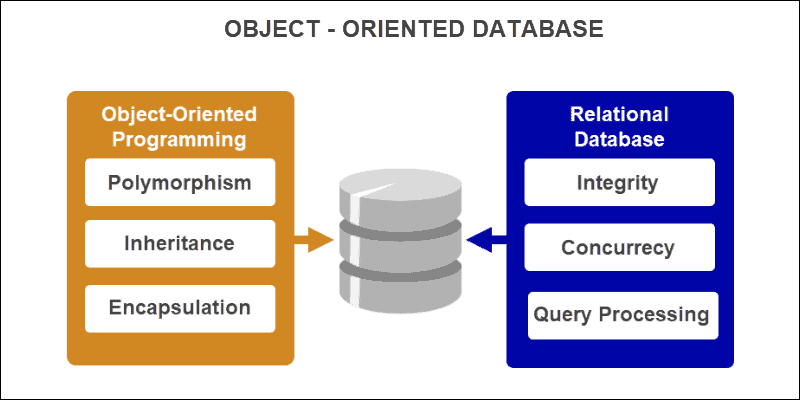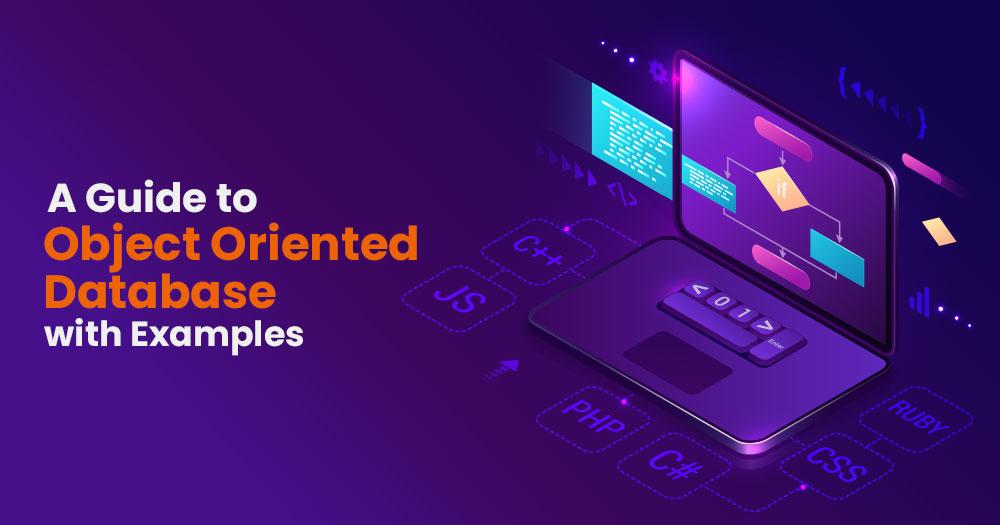Object Oriented Database Defination
An object-oriented database is a system that works with complex data objects — i.e., objects that mirror objects used in object-oriented programming languages.
In the object-oriented database, everything is an object, and many objects are quite tough, having various properties and methods. An object-oriented database management system works in particular concert with an object-oriented programming language for storing and retrieving an object-oriented database.

You must be thinking, “that I use objects in my programming most of the time. And I use a database. So, does that mean the database I use is an Object-oriented database?” the answer is no, as the reason has to do with one of the main features of Object-oriented database: object data persistence.
While the program is running, you have an object — for example, an instance of a task. That object has features like a name and status. It must also have some methods like update_task() or get_task_history(). Early in your program, you initialize that task object and now have access to it because it is stored in memory.
What happens to the program terminates execution? Your object…is gone. That data object was transient, not persistent. The next time the program starts up, there is a need to retrieve those data values (like name and status) from your object-oriented database all over again to initialize a new task object instance.
With an Object-oriented database, data objects store all their properties in the database. When the program terminates, the objects constantly persist, stored in the Object-oriented database. When your program starts up again, you can retrieve an object with the properties from the database. The process of storing and retrieving a complex data object with an Object-oriented database is transparent to the database user.
This is quite different from relational databases (like MySQL or SQLite) but not vitally from document databases (like MongoDB). In relational databases, the developer needs to have composed an object from the results of a set of queries. In document databases, mapping the document fields to the class properties should be transparent.
Object-oriented databases have been around for decades. MongoDB Realm is one of the new and promising pieces of software in this field.
Types of Object Oriented Database
- Native OODBs: These are databases designed from the ground up to support object-oriented data. Examples of native OODBs include ObjectStore and Objectivity/DB.
- Object-Relational Databases (ORDBs): These databases are a combination of traditional relational databases and object-oriented databases. ORDBs attempt to provide the best of both worlds by offering the scalability and flexibility of relational databases and object-oriented databases’ power. Examples of ORDBs include PostgreSQL and Oracle.
- Document-oriented Databases: These databases are designed to store semi-structured and unstructured data such as JSON or XML documents. Examples of document-oriented databases include MongoDB and Couchbase.
- Graph Databases: These databases are designed to store and manage graph data. Graph databases use nodes, edges, and properties to represent data and relationships between data. Examples of graph databases include Neo4j and OrientDB.
- Distributed Object Databases: These databases are designed to store object-oriented data across multiple servers or nodes. They are ideal for large-scale distributed systems where data needs to be highly available and fault-tolerant. Examples of distributed object databases include GemStone/S and VelocityDB.
Object Oriented Database Example
MongoDB does offer an object-oriented database known as Realm, in which the query language is constructed native objects through the SDK you use.
One example of an Object-oriented database is online IT training provider CBT Nuggets. CBT Nuggets useR the realm to offer more than 5,000 courses ranging from basic computer skills to tough network management . CBT Nuggets works to ensure subscribers can view content anytime.
Where are object-oriented databases used?
Object oriented databases are mostly used with object-oriented programming languages like Java, Kotlin, Node JS (React), and Swift. Industries that use object-oriented databases are typically built in an object-oriented language and want to boost productivity to work with complex data structures.
Object Oriented Programming
Object-oriented programming is a computer program designed for philosophy or methodology that organizes/ models software design over data or objects instead of functions and logic.
An object is referred to as a data field that has different attributes and behaviour. Everything in object-oriented programming is a group of self-sustainable objects.
Object-oriented programming is the most popular programming model among developers. It suits the massive, complex, and active updated or maintained programs. It simplifies software development and maintenance by giving major concepts such as abstraction, inheritance, polymorphism, and encapsulation. These core concepts support Object-oriented programming.
A real-world example of Object-oriented programming is the automobile. It more completely illustrates the power of object-oriented programming design.
Why should we use Object Oriented Programming?
Object oriented programming is an evolutionary development in software engineering. Object-oriented programming in software development is a great habit because it accomplishes the three main software engineering goals.
Where is it used?
Object oriented programming is mostly the best used when we deal with manufacturing and designing applications. It gives modularity to programming. It enables us to break down the software into pieces of small problems that we can then solve one object at a time.
Object-oriented programming should be used where the main concern is code reusability and maintenance. It makes development simple, and we can easily apprehend the code without affecting other code blocks. It should use where complex programming is a challenge.
Advantages of Object Oriented Programming
- Object oriented programming is Modular, scalable, extensive, reusable, and maintainable.
- Object oriented programming models the complex problem in an easy structure.
- Can use objects across the program.
- Code is reused.
- We can easily modify and append code without affecting the other code blocs.
- Determines the security by encapsulation and data hiding features.
- Beneficial for collaborative development in which a massive project is divided into groups.
- In object-oriented programming, Debugging is easy.
Limitations of Object Oriented Programming
- Object-oriented programming needs intensive testing processes.
- Problem-solving takes up more time in comparison to Procedure Oriented Programming.
- The programs created using object-oriented programming may become bigger than those written using the procedure-oriented programming approach.
- Software developed using object-oriented programming needs a substantial amount of pre-work and planning.
- Object-oriented programming code is difficult to understand if you do not have the correspondingly class documentation.
- These programs can take up a large amount of memory in specific scenarios.
- Not suited for small problems.
- Takes more time to solve problems.
Conclusion
In conclusion, OODBs offer a new approach to database management that integrates object-oriented programming concepts with database management. They provide faster data retrieval, flexibility, and adaptability, making them a viable option for organizations that require complex data structures and relationships. While there are challenges involved in implementing and maintaining OODBs, the benefits they offer make them an attractive option for many organizations.



I think this information is well-researched and refined for a blog.
The blog is complete as a result of the exceptionally well-curated data, analysis, and content that have been added to the object-oriented database. I believe that this piece of content is sufficient to inform readers about the fundamentals and all the information needed to begin learning from scratch. The reader’s understanding of, and use of, various aspects of databases in various spheres is clear, leaving no room for ambiguity.
Additionally, the blog is effectively organized and its content is written in a way that even readers who are unfamiliar with the subject matter can understand it.
I think this information is well-researched and refined for a blog.
The blog is complete as a result of the exceptionally well-curated data, analysis, and content that have been added to the object-oriented database. I believe that this piece of content is sufficient to inform readers about the fundamentals and all the information needed to begin learning from scratch. The reader’s understanding of, and use of, various aspects of databases in various spheres is clear, leaving no room for ambiguity.
Additionally, the blog is effectively organized and its content is written in a way that even readers who are unfamiliar with the subject matter can understand it. This, along with the other data science and blockchain blogs on the blog
I consider this content to be well-researched and polished for a blog.
The blog is now complete thanks to the exceptionally well-curated data, analysis, and content that have been added to the object-oriented database. The data in this post, in my opinion, is adequate to provide readers with all the background knowledge they require to begin learning from beginning. Because the reader is familiar with and adept at using the many components of databases, there is no room for uncertainty.
The website is also well-organized, and its content is written in a way that even users with less subject knowledge may understand it. This and the other articles on the website regarding blockchain and data science
Amazing content, a great learning opportunity. Keep it up Team Brainalyst
Was new to this database thing but the way this blog summarized it from the scratch. Its really helpful to have a such a great platform for all these data base related thing
Well researched and refined sections, reading it definitely enriched my knowledge.
Reading this blog was a really good decision as it was pretty easy to understand and very informative while simultaneously being interesting, will recommend my friends to read it too!